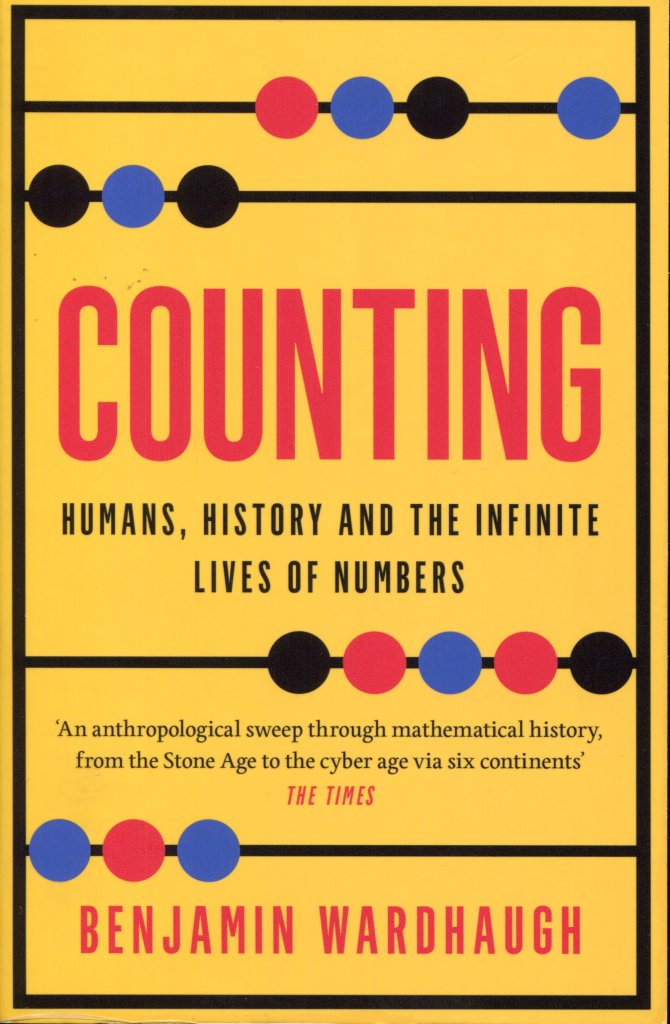Back in 2020, I penned a very favorable review of Benjamin Wardhaugh’s intricate work, The Book of Wonder: The Many Lives of Euclid’s Elements. This prompted me to also compose a positive critique of Reading Mathematics in Early Modern Europe, to which Wardhaugh contributed and edited. Subsequently, I wrote a brief blog entry about the research initiative, Reading Euclid, that inspired both books.
Recently, I was delighted to receive an email from Benjamin Wardhaugh inquiring if I would be interested in a copy of his latest book, Counting: Humans, History and the Infinite Lives of Numbers (William Collins, 2024). Given my genuine interest in the history of numbers and the exceptional quality of Wardhaugh’s Euclid volume, I readily accepted. I have not been let down.
As I noted earlier, I have a keen interest in the history of numbers, but as Wardhaugh highlights, while numbers have been and are utilized in counting, they are not strictly necessary for the task, and there has historically been ample counting done without them. At one point, while skimming through the book and getting a feel for it, I found myself chuckling, thinking this is much more anthropology than history. That was when I took the time to read the quote from The Times on the front cover:
“An anthropological sweep through mathematical history from the Stone Age to the cyber age via six continents.”
Histories of science or related subjects typically adhere to a linear chronological narrative and, within limits, aim to be thorough. One should not expect this with Wardhaugh’s engaging, thought-provoking dive into the history of counting. Why not? Wardhaugh provides an explanation in the introduction, which is not a continuous narrative but a series of fragmented quotes that highlight aspects of what counting is or might be. In response to the question, “But what is it?” Wardhaugh informs the reader:
“‘Counting’ can appear as an unruly collection of almost entirely unrelated actions; a term encompassing a vast array of distinct cultural practices. The variety of activities labeled as counting seems uncomfortably broad, and at least on the surface, it’s unclear what they all share in common; or if they share anything in common at all.
Any definition of counting poses challenges, but one of the most notable is attributed to the seventeenth-century German philosopher Gottfried Leibniz. It asserts that counting is repeated attention. Counting occurs when you consider ‘this…this…this…this’, and have some way of keeping track.”
Wardhaugh continues:
“Counting does not have a singular history.”
[…]
“The narrative of counting is shaped more like a tree. It has multiple roots, numerous branches, and countless twigs and leaves. Counting has evolved and traveled alongside the human species, branching out into nearly every culture, past and present. Occasionally, it is feasible to trace a single branch for some distance: at other times, a branch appears to intertwine, to touch (or nearly touch) others.”
In this book, Wardhaugh guides his readers first on a descent into the root system, then upward along some of the branches, traversing time and continents; stopping to examine a twig, pluck a leaf, or savor some ripe fruit. The book is structured not as a continuous narrative but divided into eight sections, two of which explore the roots, while the other six navigate the diverse branches.
Each of the eight sections comprises a collection of self-contained essays that address an example or facet of the topic outlined in the section’s title. In those sections focusing on examples of counting, which constitutes most but not all, Wardhaugh meticulously details who does the counting, what is counted, how it’s counted, and crucially, why it’s counted. Through this, he makes it abundantly clear that counting is, as he stated in his introduction, ‘an unruly grab-bag of almost totally unrelated actions’.
The first Roots section does not address counting directly but focuses on Number sense prior to counting and includes three essays discussing how individuals estimate the size of groups of objects without counting and whether this ability is unique to humans or shared with animals.
The second Roots section, Counting before writing, presents three essays on artifacts uncovered in prehistoric Africa that may have played a role in counting processes. Wardhaugh offers compelling arguments for such usages, but also cautions that ultimately the claims remain conjectural. A fourth essay speculatively but convincingly discusses the potential origins of counting words.
Between the Roots sections and the Branches lies an interlude regarding numbers and their nature.
We now enter the domain of counting in a section titled, Counting with words and symbols in the Fertile Crescent. The first essay here discusses the Sumer
